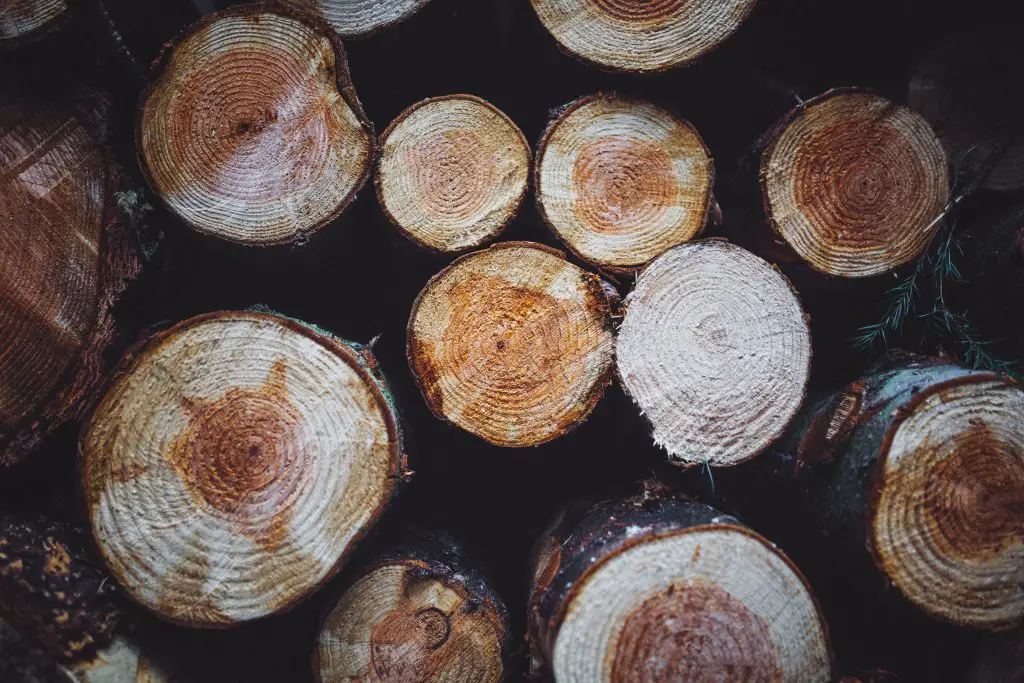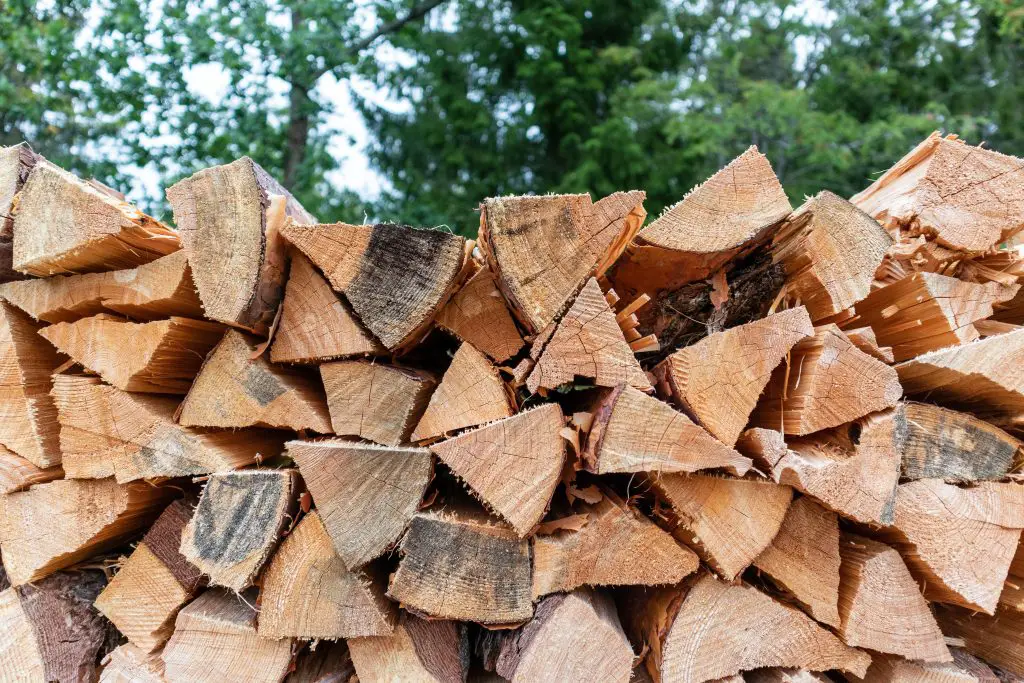What you find on this page:
Firewood has a way of quite literally piling up.
You start by splitting one or two choice logs, and the next thing you know, you’ve got yourself a sizable stack of wood ready to heat your home as the days get shorter and colder. If that stack grows, it might eventually add up to a rick.
Don’t feel bad if you just paused to ask, “What the heck is a rick?” It’s not a term that most people are familiar with, but it can be a good one to know if you ever plan on buying (or selling) firewood in bulk.
The following overview will help shed some light on this curious bit of wood-cutting lingo and what it amounts to as regards proportion and price.
What Is a Rick of Wood?
In modern parlance, the term “rick” is used to describe a given amount of cut, stacked firewood.
This peculiar designation didn’t always carry metric connotations. It originally referred to the manner in which wood was arranged and stored rather than indicating any specific quantity. The contemporary word “rick” has its roots in the Old English word “hreac,” which simply meant a mound of logs cut to an even length.
Since as far back as the ninth century, it’s been customary to lay out fresh-cut firewood in ricks or stacks of a more or less consistent size. That practice is still going strong today—if you’ve ever driven past a quaint country house and seen a mound of neatly-hewn logs covered up with a tarp sitting near the woodline, you were looking at a rick and didn’t even know it.
Over time, the characteristic dimensions of these stacks have come to be implied in their name itself, so that a rick is now both a way of stacking wood and a de facto unit of measurement for appraising the resulting stack.
How Big Is a Rick of Wood?
A standard-sized rick of firewood, if there can be said to be such a thing, measures approximately four feet high by eight feet long.
Why these precise measurements? Why not, say, 3’x5’x36” or, better yet, an even 4’x4’x4’?
The most straightforward answer is that in preparing for the long, grueling winters of yesteryear, the originators of the rick probably just hit upon a successful configuration by chance. Presumably, that configuration was widely adopted and became a formalized way of doing things.
Tradition aside, an experienced woodcutter would tell you that sticking with the “orthodox” dimensions results in a more secure and orderly stack. A rick with a base that’s a full eight feet long will naturally be more stable than one with a base of only five feet, especially if the height of the stack doesn’t change.
Furthermore, the standard rick makes a thoroughly practical unit of measurement, as no single household is likely to amass enough wood in a single season to create a stack that spans much longer than eight feet and stands much higher than four.
All that said, there’s sometimes a bit of variation when it comes to the width of a rick.
It all comes down to the length of the individual logs that make up the stack. If the person chopping the wood sees fit to cut all the logs to a uniform 16 inches, the completed rick will come out to 4’x8’x16”. Similarly, if they decide to leave the logs a little longer, the rick may end up being 4’x8’24” once all the members have been gathered up.

How Much Does a Rick of Wood Weigh?
This is another area where there can be many variations depending on the type of wood the rick is made up of.
For example, a rick of lightweight wood like spruce or cedar might weigh somewhere in the neighborhood of 600-700 pounds. One pieced together from a denser, heavier wood like oak, maple, or beech, on the other hand, might easily top two tons.
That’s undeniably heavy, but not unexpectedly so. After all, there may be anywhere from 275 to 350 pieces of wood in each rick! The length of the logs is just as important a factor in terms of heft as the wood they’re cut from. The wider the rick is, the more it will weigh.
It will be essential to account for these sorts of specs if you intend to purchase a rick of firewood, as the overall size and weight of the stack may determine where you’re able to station it on your property.
How Many Ricks Are in a Cord of Wood?
As big as a rick of firewood is, it’s still not as big as a cord.
A cord is another standard unit of measurement used to parcel out firewood, one that more people are likely to have heard of. Unlike a rick, a cord of firewood always has a fixed set of dimensions—in this case, four feet high by eight feet long by four feet wide.
A standard rick is therefore only about 1/3 to 1/2 the size of a cord, generally speaking. In fact, cords are composed of ricks: the four-foot width of a cord is made up of multiple ricks, each of a narrower width, arranged back-to-back.
For this reason, ricks are sometimes known as “face cords.” They received this nickname because they’re identical to full cords when viewed head-on, thanks to the fact that they share two out of three primary dimensions.
You could say that ricks are like the modular components of cords. If each of the logs in a rick were cut to 16”, the cord would contain a total of three ricks; if the logs were cut to 24”, the cord would have only two ricks.
To help you visualize the aforementioned configurations, here’s a simple diagram depicting how they would look from a top-down perspective:
Many firewood vendors sell their wares by the rick or by the cord, divvying up the proportions in a similar fashion to what you see above. Doing so gives buyers more options for financing and allotting the necessary space for their firewood.

How Much Is a Rick of Wood?
If you’re thinking about purchasing a rick of wood to keep on hand for your fireplace or wood-burning stove, you’ll first want to make sure that such an expenditure fits your budget.
Even though it’s a renewable resource, wood is a hot commodity, particularly in regions with colder climates. As a rule, cheaper woods aren’t good for burning, and woods that are good for burning aren’t cheap. In other words, you get what you pay for—a saying that’s true of just about all consumer goods, even the ones supplied by nature.
Let’s say you want to order a single rick of premium oak firewood. As a ballpark estimate, you should be prepared to drop around $150-300 for the wood alone.
It’s always possible that you could score a sweet deal on a stack from a small-time local vendor, but it’s also possible that you’ll find yourself with no choice but to shell out more if demand is sufficiently high in your area.
Additional Costs
Firewood distributors don’t just charge a flat rate for their products. Many other expenses are involved in their trade that are passed on to the buyer.
For starters, someone has to gather, cut, inspect, warehouse, and deliver all that wood, which means you can expect to pay an extra $10-30 per rick on average to cover the cost of labor. That’s not so much when you consider the countless hours and untold amounts of sweat and elbow grease you stand to save by not having to chop that much wood yourself.
Service Fees
Also, keep in mind that different vendors charge different fees for auxiliary services. On top of the market value of the wood itself (which can range widely based on variety, regional demand, and season), the distributor you get your wood from might impose additional charges for delivery, stacking, and shelter.
These charges might only increase your total by a few dollars in some cases. In others, they could come close to matching the cost of the core materials. It’s always a good idea to talk to a vendor before you commit to a transaction to get a sense of their pricing policies and decide whether or not you have the spending power to do business with them.
On the plus side, a rick of quality firewood will most likely last you somewhere between 6 and 12 weeks. As such, it shouldn’t be necessary to purchase more than one or two per year, even if you exclusively use wood to heat your home.
Conclusion
In the future, as you take steps to insulate yourself against winter’s invasive chill, consider buying your firewood by the rick. One of these time-honored stockpiles should provide you with enough fuel to keep your home warm, welcoming, and well-guarded against the cold all season long.






